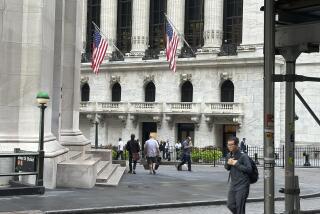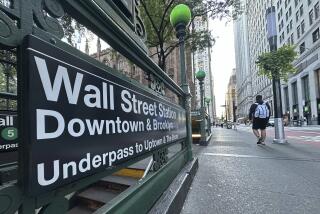Still Fretting for the Economy? Just Look at the Auto Business
Panic is caused by unstable prices and short memory. Turmoil in the financial markets is leading otherwise sensible people to lose their balance and to doubt the strength of the real economy. The Federal Reserve Board is criticized for acting too quickly or too slowly on interest rates; inflation or recession or both are coming, cry the doomsayers.
Reality is more complex and encouraging. The economy is truly strong and likely to be so for four or five years--as can be seen from a good look at the automobile business. That most basic and evocative American industry is in its best shape in two decades and offers an excellent example of trends in the real economy.
But first, turmoil in financial markets may continue for a month or two. Stock and bond prices are bouncing around--they rose Tuesday after a deep dive Monday--not really because of inflation or Fed policy, but because billions of dollars of speculation in U.S. Treasury notes and bonds is being liquidated by big-money investors who borrowed heavily to play in the government bond markets.
That’s unnerving and affects interest rates for business, housing and personal loans. But such effects are temporary, as history shows. Similar bond market turmoil occurred in 1958, reports James Grant, editor of Grant’s Interest Rate Observer, in the “ostensibly serene years of the second Eisenhower Administration.”
Then as now, Grant relates, investors borrowed money to play the spread between low short-term interest rates and high long-term rates. Corporations, too, sought to pick up a quick buck speculating on interest rates--as Procter & Gamble and others have done recently in derivatives. But all were confounded when Treasury bill rates rose from 1% in the summer of 1958 to 4% a year later.
Yet back then, the stock market went right on rising and the real economy started its long, healthy, non-inflationary march through the first half of the 1960s.
Rising interest rates didn’t stop the economy then. Nor is business activity slowing today. On the contrary, banks are lending to small business again for the first time since 1990. And they are pushing car loans for the first time in more than a decade.
Which brings us to the car business. U.S. car and truck sales are running at an annual rate of 15.5 million vehicles, which is almost historic. But most experts think sales will go even higher in the next few years. Chrysler and Ford are selling everything they make and expanding capacity. Furthermore, they have dramatically improved operations. Chrysler developed the new Neon in just 31 months; Ford is unifying its manufacturing worldwide. General Motors is doing better than it has in a decade, with further product improvements coming in the next few years.
Demand is so heavy that Japanese car makers, whose prices have been forced up by the high yen, nonetheless are having a good year because leasing deals are moving cars for them.
Yet auto stocks are down--Chrysler from $61 a share to about $46 currently, Ford from more than $70 a share to about $59, and General Motors from $65 to $55--because rising interest rates have frightened the stock market.
Investors think higher rates will slow car buying. But a look at the numbers tells you that’s not so, says analyst Joseph Phillippi of Lehman Bros. “These higher rates will add about $7 a month to the average car loan payment,” Phillippi says. “That won’t stop this car rally.”
A relatively new wrinkle, leasing, is moving cars out of showrooms. Individual leases, as opposed to company fleet deals, now account for more than one-fifth of all new cars purchased, says Doug Kevorkian, an automotive consultant in Ann Arbor, Mich. More than half of all luxury cars are leased, he adds, because leases allow for lower down payments and often lower monthly payments than a conventional loan.
One reason is that manufacturers subsidize leases through their finance companies, which leads some on Wall Street to worry about future write-offs if car values at the end of the leases are lower than financiers had predicted. The effect on the used car market is also imponderable.
Like so much else in America, the car business is changing. The rise of leasing, which experts think will level off at one-third of all cars sold, reflects different lifestyles. Many people like the idea of hassle-free service and a new luxury car every two years. Auto companies and dealers, in turn, like the idea of customers coming back all the time for repairs or a new lease.
So cars will become somewhat like housing, where many people rent their homes. There will be financial innovation as markets develop automobile loan paper similar to mortgage pass-through certificates.
There is one shadow on the rosy picture. U.S. car makers have taken advantage of their Japanese competitors’ problems with the yen to raise prices themselves, taking profit today rather than market share for tomorrow. That could come back to haunt them, because U.S. auto makers are still a hair behind Toyota and Nissan, which can go from drawing board to finished car in 30 months.
So it remains a competitive world. Still, Detroit in the next few years will move a lot of iron, as they say, and other industries will move a lot of merchandise and services too. The economy’s strength is real.
But that doesn’t necessarily mean a bull market, says master investor Peter Lynch of Fidelity Investments. The next 12 months could see a further 12% decline in stock prices, Lynch said recently in Barron’s. Such a bear market--a decline of about 25% in major stock averages--has occurred every six years throughout this century.
Yet even that wouldn’t stop profits of most U.S. companies from rising. And that’s the reality that will drive stock prices higher over the next four to five years, Lynch said--demonstrating that a long memory and a calm perspective are keys to understanding and investment success, especially in these panicky times.






